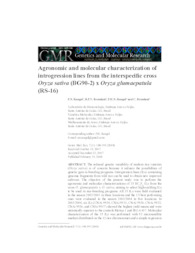Agronomic and molecular characterization of introgression lines from the interspecific cross Oryza sativa (BG90-2) x Oryza glumaepatula (RS-16).
Agronomic and molecular characterization of introgression lines from the interspecific cross Oryza sativa (BG90-2) x Oryza glumaepatula (RS-16).
Author(s): RANGEL, P. N.; BRONDANI, R. P. V.; RANGEL, P. H. N.; BRONDANI, C.
Summary: The reduced genetic variability of modern rice varieties (Oryza sativa) is of concern because it reduces the possibilities of genetic gain in breeding programs. Introgression lines (ILs) containing genomic fragments from wild rice can be used to obtain new improved cultivars. The objective of the present study was to perform the agronomic and molecular characterizations of 35 BC2F8 ILs from the cross O. glumaepatula x O. sativa, aiming to select high-yielding ILs to be used in rice-breeding programs. All 35 ILs were field evaluated in the season 2002/2003 in three locations and the 15 best performing ones were evaluated in the season 2003/2004 in five locations. In 2003/2004, six ILs (CNAi 9934, CNAi 9931, CNAi 9930, CNAi 9935, CNAi 9936, and CNAi 9937) showed the highest yield means and were statistically superior to the controls Metica 1 and IRGA 417. Molecular characterization of the 35 ILs was performed with 92 microsatellite markers distributed on the 12 rice chromosomes and a simple regression quantitative trait locus analysis was performed using the phenotypic data from 2002/2003. The six high-yielding ILs showed a low proportion of wild fragment introgressions. A total of 14 molecular markers were associated with quantitative trait loci in the three locations. The six high-yielding ILs were incorporated in the Embrapa breeding program, and the line CNAi 9930 is recommended for cultivation due to additional advantages of good grain cooking and milling qualities and high yield stability. The O. glumaepatula-derived ILs proved to be a source of new alleles for the development of high-yielding rice cultivars.
Publication year: 2008
Types of publication: Journal article
Unit: Embrapa Rice & Beans
Observation
Some of Embrapa's publications are published as ePub files. To read them, use or download one of the following free software options to your computer or mobile device. Android: Google Play Books; IOS: iBooks; Windows and Linux: Calibre.
Access other publications
Access the Agricultural Research Database (BDPA) to consult Embrapa's full library collection and records.
Visit Embrapa Bookstore to purchase books and other publications sold by Embrapa.

